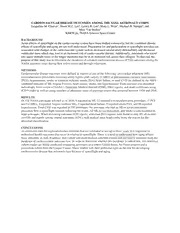
NASA Technical Reports Server (NTRS) 20170010301: Cardiovascular Disease Outcomes Among the NASA Astronaut Corps PDF
Preview NASA Technical Reports Server (NTRS) 20170010301: Cardiovascular Disease Outcomes Among the NASA Astronaut Corps
CARDIOVASCULAR DISEASE OUTCOMES AMONG THE NASA ASTRONAUT CORPS Jacqueline M. Charvat1, Stuart M.C. Lee1, Lesley R. Lee1, Mary L. Wear1, Michael B. Stenger2, and Mary Van Baalen2 1KBRWyle, 2NASA Johnson Space Center BACKGROUND Acute effects of spaceflight on the cardiovascular system have been studied extensively, but the combined chronic effects of spaceflight and aging are not well understood. Preparation for and participation in spaceflight activities are associated with changes in the cardiovascular system such as decreased carotid artery distensibility and decreased ventricular mass which may lead to an increased risk of cardiovascular disease. Additionally, astronauts who travel into space multiple times or for longer durations may be at an increased risk across their lifespan. To that end, the purpose of this study was to determine the incidence of common cardiovascular disease (CVD) outcomes among the NASA astronaut corps during their active career and through retirement. METHODS Cardiovascular disease outcomes were defined as reports of any of the following: myocardial infarction (MI), revascularization procedures (coronary artery bypass graft surgery [CABG] or percutaneous coronary intervention [PCI]), hypertension, stroke or transient ischemic attack [TIA], heart failure, or total CVD (as defined by the AHA - combined outcome of MI, Angina Pectoris, heart failure, stroke, and hypertension). Each outcome was identified individually from review of NASA’s Electronic Medical Record (EMR), EKG reports, and death certificates using ICD-9 codes as well as string searches of physician notes of astronaut exams that occurred between 1959 and 2016. RESULTS Of 338 NASA astronauts selected as of 2016, 9 reported an MI, 12 reported a revascularization procedure, (7 PCI and 5 CABG), 4 reported Angina (without MI), 5 reported heart failure, 9 reported stroke/TIA, and 96 reported hypertension. Total CVD was reported in 105 astronauts. No astronaut who had an MI or revascularization procedure flew a spaceflight mission following the event. All MI, revascularization, and stroke events occurred in male astronauts. When reviewing astronaut ECG reports, abnormal ECG reports were found in only 8% of records (n=430) and mainly among retired astronauts (82%), with marked sinus bradycardia being the reason for the abnormal classification. CONCLUSIONS As astronauts train for exploration-class missions that are estimated to last up to three years, it is important to understand health outcomes that occur in relation to spaceflight. There is a need to understand how aging affects these outcomes as well. It appears that current astronaut medical selection criteria and preventive measures keep the incidence of cardiovascular outcomes low. In order to determine whether this incidence is indeed low, two historical cohort studies are being conducted comparing astronauts to a cohort United States Air Force aviators and a prevention cohort from the Cooper Center. These studies will shed additional light on the risk for developing cardiovascular disease that astronauts face because of spaceflight and aging.
